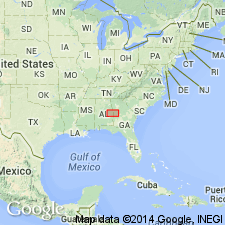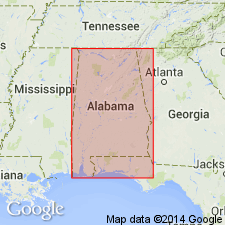
- Usage in publication:
-
- Rock Mills Granite
- Modifications:
-
- Named
- Dominant lithology:
-
- Granite
- Gneiss
- AAPG geologic province:
-
- Piedmont-Blue Ridge province
Summary:
Name Rock Mills granite introduced in this report for granitic gneiss of the Dadeville Complex exposed at Rock Mills, Randolph Co., AL. Consists of two varieties: a coarse-grained, slightly foliated leucocratic-granite gneiss and a well-foliated biotite-granite gneiss. The two varieties occur mixed together and their relationship is unclear. Predominant minerals are biotite, microcline, oligoclase, and quartz. Age is early Paleozoic
Source: GNU records (USGS DDS-6; Reston GNULEX).

- Usage in publication:
-
- Rock Mills Granite Gneiss
- Modifications:
-
- Overview
- AAPG geologic province:
-
- Piedmont-Blue Ridge province
Summary:
Rock Mills Granite Gneiss of Dadeville Complex described here as slightly foliated medium- to coarse-grained leucocratic granite gneiss and a well-foliated biotite granite gneiss, composed of biotite, microcline, oligoclase, and quartz with rutile and zircon as accessory minerals. Locally epidote-rich. May include thin, small amphibolite bodies.
Source: GNU records (USGS DDS-6; Reston GNULEX).
For more information, please contact Nancy Stamm, Geologic Names Committee Secretary.
Asterisk (*) indicates published by U.S. Geological Survey authors.
"No current usage" (†) implies that a name has been abandoned or has fallen into disuse. Former usage and, if known, replacement name given in parentheses ( ).
Slash (/) indicates name conflicts with nomenclatural guidelines (CSN, 1933; ACSN, 1961, 1970; NACSN, 1983, 2005, 2021). May be explained within brackets ([ ]).

